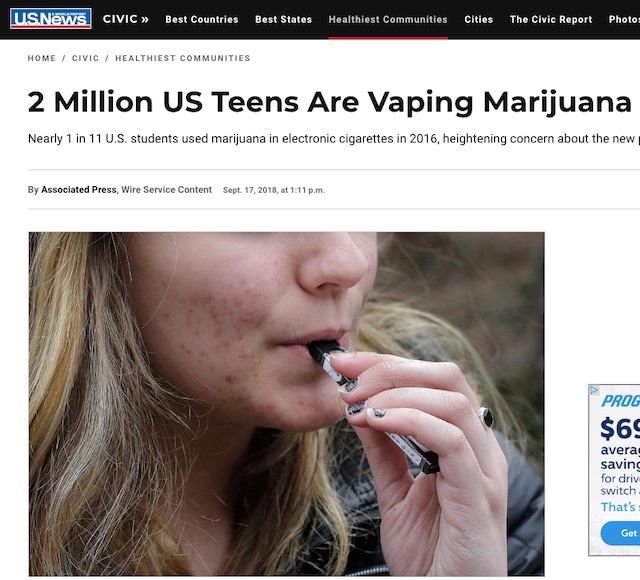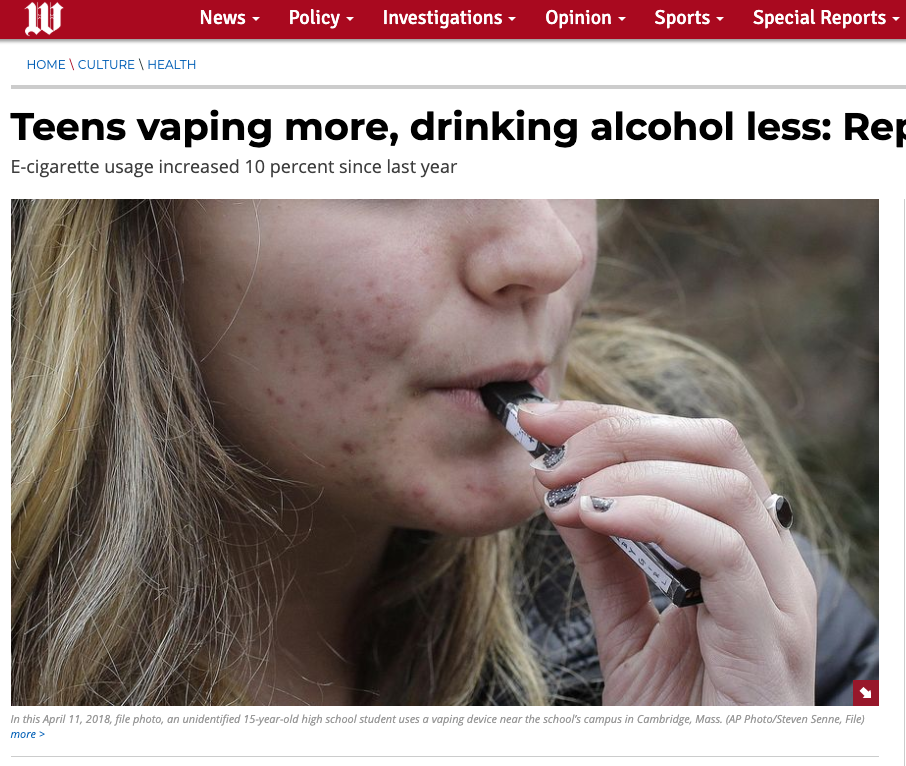Media manipulation via stock photo

Have you seen this girl? I bet you have. And she’s there to make you angry.
This image is from an article from U.S. News. The photo, by Steve Senne of AP, is “an unidentified 15-year-old student at a high school in Cambridge, Mass.” There was no need to get a photo release, because without the rest of her face you can’t tell who she is.
But if you think vaping is a dirty habit, this photo is ready to confirm your bias. Look closely. She has acne, dry hair with split ends, and chipped, mottled nail polish. She looks like an addict. She the poster child for how vaping makes you lazy about your appearance or how people who don’t take care of themselves are attracted to vaping. (When it comes to prejudice, the causality can go whatever way you want.)
This girl is irresistible to photo editors. Here’s a sampling on a variety of news articles.
- Shreveport Times: La. lawmakers back limiting vape sales to minors
- KPBS: FDA Intensifies Crackdown On E-Cigarette Sales To Teenagers
- Vice: This High School Is Locking Down Most of Its Bathrooms to Stop Students from Vaping
- NBC Bay Area: 22 People Have Been Hospitalized With Vaping-Linked Breathing Problems
- Univision: Cigarrillos electrónicos: una moda que aumenta peligrosamente entre los adolescentes
- Washington Times: Teens vaping more, drinking alcohol less: Report
- HuffPost: FDA To Restrict Sales Of Fruit And Candy-Flavored E-Cigarettes
- Quartz: After conquering the US, Juul e-cigarettes are going global




A picture manipulates better than a thousand words
Photo editors pick photos to illustrate what they publish. For most articles, there’s no photo of the actual event, so they go rooting through the stock photo bin. If the article is about how vaping is bad, why not pick a photo of a girl with acne and a bad nail job?
I’m no fan of vaping. I think it’s a scourge. But that’s not the point. The point is that photos are even more persuasive than words — and they don’t trip our alarm bells. If the headline said “Dirty, skanky vapers are risking their lives and wasting our health care resources,” you’d think “That sure sounds like a biased article.” But the photo does the same job much more effectively, since you don’t see it coming.
I know how this works. As the photo editor of this blog, I choose pictures for impact as well — and, I hope, do it in a way that’s transparent.
What does this mean?
If you’re reading news, it means you should ask yourself how much the choice of photos is influencing your perspective. If it’s a photo of millions of protestors in Hong Kong, then your “wow” is probably justified. If it’s a stock photo chosen to manipulate you, maybe not.
And if you’re publishing content, be aware of the messages you send with photos. Choosing that first pic from the stock photo search might make you into a manipulator, even if you didn’t mean to be.
Excellent piece, Josh! BRAVO!
We in the graphic design and advertising industry have warned against and fought against such practice for a half century, from the very first days of photographic “clip art”.
Now the internet has only compounded this problem!
Josh, all true. As usual, the flipside is also true. Evocative photos can manipulate (inspire, lure, teach, etc) by creating good feelings, something other than anger anyway. You know this, and as a pro blogger, too, I have to choose from free photos every day for clients. For myself, I create my own. This is a good warning that photos are not nothing, and all those ads at the bottom of clickbait posts/articles are carefully crafted to engender certain thoughts and feelings. That’s super duper important. We are numb to it, how we’re being manipulated every minute, every day.